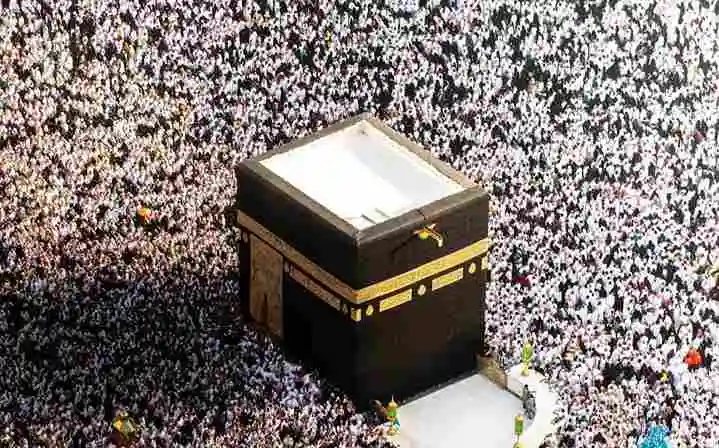Hajj is one of the five pillars of Islam, a deeply significant religious duty and an extraordinary spiritual journey for Muslims across the globe. Every year, millions of Muslims gather in the holy cities of Mecca, Medina, and other significant sites in Saudi Arabia to perform rituals that date back to the time of the Prophet Ibrahim (Abraham). Hajj is not only a physical journey but a deeply transformative spiritual experience that cleanses the soul and brings believers closer to God.
The Significance of Hajj: An Overview
Hajj, meaning “to intend a journey” in Arabic, is an obligation for every Muslim who is physically and financially capable of undertaking it. The pilgrimage must be performed during a specific period of the Islamic calendar, which falls between the 8th and 12th of Dhu al-Hijjah, the last month of the Islamic lunar year.
Here are the key Elements of Hajj:
Ihram: Pilgrims enter into a state of spiritual purity by donning simple white garments. This symbolizes the equality of all pilgrims, as they stand before God without any distinction.
Tawaf: Pilgrims walk seven times in a counter-clockwise direction around the Kaaba, the sacred structure in the center of Masjid al-Haram in Mecca, symbolizing unity with God.
Sa’i: After Tawaf, pilgrims walk between the hills of Safa and Marwah, commemorating the search for water by Hagar, the wife of Prophet Ibrahim.
Arafat: On the 9th of Dhu al-Hijjah, pilgrims gather at the plain of Arafat for a day of prayer, asking for forgiveness and making supplications.
Mina and Stoning of the Jamarat: Pilgrims throw pebbles at three pillars, symbolizing the rejection of Satan’s temptations.
For millions, Hajj is a once-in-a-lifetime opportunity, but the journey is so much more than just a religious duty. It is a profound moment of personal reflection, global unity, and spiritual rejuvenation.
The Hajj 2025 Experience: What to Expect
The Hajj 2025 experience is set to be monumental, with the return of pre-pandemic pilgrimage numbers, likely exceeding 3 million pilgrims. Saudi Arabia’s Vision 2030 initiatives will enhance infrastructure, including expanded transportation networks like the Mecca Metro and the ongoing expansion of the Grand Mosque in Mecca. With a focus on digital solutions and health protocols, pilgrims will benefit from smarter crowd management and improved safety measures. This year will also emphasize sustainability, with eco-friendly initiatives aimed at reducing waste and conserving resources.
Expected Number of Pilgrims
Hajj 2025 will likely see significant numbers of pilgrims, especially as Saudi Arabia has lifted many of the COVID-19 restrictions that limited attendance in previous years. The Saudi authorities have set ambitious goals to increase Hajj capacity as part of their Vision 2030 plans, which aim to allow over 30 million visitors annually to the Kingdom by 2030.
Some statistics from recent years indicate:
- 2023: Around 2.6 million people performed the Hajj.
- 2024 (projected): Close to 3 million.
- 2025 (projected): As restrictions have lifted, experts expect the number to return to pre-pandemic levels or even exceed 3 million, making it one of the largest pilgrimages in history.
Saudi Arabia’s Vision 2030 includes enhancing infrastructure to support such an influx, focusing on modernizing transport systems, increasing accommodations, and providing better services for pilgrims.
The Infrastructure Transformation: Mega Projects for Hajj 2025
The Saudi government has been investing heavily in infrastructure improvements to accommodate the growing number of pilgrims. For 2025, these improvements will play a critical role in the efficiency and safety of the pilgrimage.
The Mekkah Metro: The Mekkah Metro, a fast transportation network that links Mecca, Mina, and Arafat, has already significantly eased the transportation burden during Hajj. It is expected to play an even more crucial role in 2025, helping pilgrims travel efficiently between major Hajj sites.
Expansion of the Haram: The Grand Mosque in Mecca is undergoing a major expansion to accommodate more worshippers. This includes enlarging the Tawaf area around the Kaaba and increasing the number of prayer spaces. By 2025, the capacity of the Haram is expected to increase significantly.
Smart Hajj Initiatives: Saudi Arabia is incorporating digital technology into the Hajj experience, from AI-powered crowd management systems to mobile applications that help pilgrims navigate the holy sites. The “Smart Hajj” initiative aims to make the pilgrimage safer and more efficient by monitoring crowd density, ensuring safe access to key sites, and providing real-time alerts for pilgrims.
Expanded Health and Safety Measures: Ensuring the health and safety of millions of people from different parts of the world is a top priority. In 2025, there will likely be enhanced health protocols, including better sanitation and hygiene standards, medical facilities, and surveillance systems to prevent the spread of infectious diseases.
Environmental Sustainability
In line with global environmental concerns, Saudi Arabia is committed to ensuring that the Hajj is a sustainable event. The country has already initiated steps to minimize waste, reduce carbon emissions, and improve water management in Mecca and Medina. For 2025, further green initiatives are expected to include:
- Solar energy projects for powering essential services.
- Water conservation measures and recycling efforts are being implemented to manage the high demand for water during the pilgrimage.
- Sustainable waste management practices to reduce environmental impact.
Economic Impact: The Multibillion-Dollar Industry of Hajj
Hajj is a major economic driver for Saudi Arabia, bringing in billions of dollars annually from a variety of sources:
- Pilgrim-related spending: This includes everything from travel, accommodation, and food to special products and souvenirs sold in Mecca and Medina.
- Government investment: The Saudi government spends heavily on infrastructure, services, and security measures required to manage the pilgrimage, including the expansion of transportation, accommodation, and health services.
In 2025, with the increasing number of pilgrims, the total economic impact of Hajj is projected to surpass $12 billion. This makes it one of the largest single tourism events in the world, with direct and indirect benefits to the Saudi economy.
The Spiritual Experience of Hajj
For Muslims, the significance of Hajj goes far beyond the physical aspects of the journey. The pilgrimage is a deeply spiritual experience that offers an opportunity for self-reflection, renewal of faith, and the seeking of God’s mercy. Here’s why:
- Forgiveness and Redemption: Pilgrims believe that performing Hajj properly leads to the forgiveness of their sins, as stated in various Hadiths. This makes Hajj not only an act of worship but also a means of spiritual purification.
- Global Unity: One of the most powerful aspects of Hajj is the overwhelming sense of unity. Pilgrims come from every corner of the world, speaking different languages, with different cultures, but they all share the same goal: to worship God. This unity is reflected in the simple white Ihram garments, which eliminate distinctions of class, nationality, and race.
- Reflection on the Lives of Prophets: During Hajj, pilgrims retrace the steps of the Prophet Ibrahim, his wife Hagar, and their son Isma’il (Ishmael), gaining insight into the stories of sacrifice, faith, and devotion.
Preparing for Hajj 2025: Practical Tips for Pilgrims
Visa and Documentation: Pilgrims need to apply for a Hajj visa, which can be obtained through Saudi-approved travel agencies. It is important to start this process early, as the demand for Hajj visas is high.
- Health and Vaccinations: Pilgrims must meet certain health requirements, including vaccinations for diseases like meningitis and seasonal influenza. It is also advisable to undergo a medical check-up before embarking on the pilgrimage.
- Physical Preparation: Hajj involves a great deal of walking, sometimes in very hot conditions. Pilgrims should prepare physically by walking long distances, strengthening their stamina, and familiarizing themselves with the physical demands of the pilgrimage.
- Financial Planning: Hajj can be expensive, with costs including travel, accommodation, food, and Hajj packages. Pilgrims should plan their finances well in advance and consider opting for packages that include guided tours and accommodations close to the sacred sites.
- Mental Preparation: Beyond the physical and logistical aspects, pilgrims should also prepare mentally and spiritually for the journey. Reflecting on the purpose of Hajj and making sincere prayers can enhance the overall experience.
Hajj 2025 as a Monumental Journey
As Hajj 2025 draws closer, the world is preparing for what will likely be one of the largest and most significant gatherings in history. With ongoing infrastructure projects, technological advancements, and a renewed focus on sustainability, the experience of performing Hajj will continue to evolve. However, at its core, Hajj will always remain a deeply personal and spiritual journey, uniting Muslims from across the globe in worship and reflection. Whether you are planning to participate or simply observing from afar, Hajj is a testament to the power of faith, unity, and devotion in an increasingly interconnected world.






